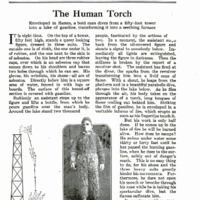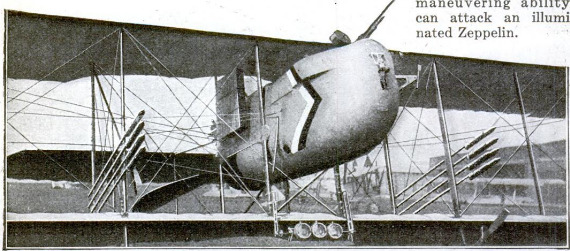French night-roaming airplane
Item
-
Title (Dublin Core)
-
French night-roaming airplane
-
Article Title and/or Image Caption (Dublin Core)
-
The Mechanical Owl of the French Army. A night-roaming airplane with rockets and searchlights to throw light on a Zeppelin's intentions
-
Caption: The rockets on this night machine are electrically discharged. They are for use when
darkness confuses the aviator. Each rocket carries a flare at the end of a parachute
-
extracted text (Extract Text)
-
NIGHT flying has become a military
necessity for reconnoitering and
bombing as well as for attacking
Zeppelins, which always bomb at night.
Extraordinary demands are made on the
skill of the pilot. A landing at night can
be safely made only if the ground is il-
luminated or guiding beacons are em-
ployed. Were it not for the fact that the
average night sky is not pitch black and is
even slightly luminous, night flying would
be even more dangerous than it is. Yet
on those nights when overhanging clouds
cut off even this faint luminosity, when
everything is wrapped in inky blackness,
it may be necessary to send an aviator
aloft.
Recently the French had to convert the
night plane into something like an owl, so
that it can fly even on pitch dark nights.
Like an owl, the machine, with which they
have experimented, is very slow—an old-
fashioned Farman “pusher” which would
fall a ready prey to a fast enemy machine
in daylight. But how does it find its
way? By illuminating devices, of course.
‘They may not be heavy because the ma-
chine cannot carry much additional
weight. There are three luminous eyes in
the form of searchlights mounted on the
lower plane, as our photograph shows.
As the owl swoops down on its prey, they
flare up and enable the pilot to single out
the target.
But sometimes the searchlights are in-
adequate. Greater efficiency is often de-
manded. And so we find that the ma-
chine carries as well eight illuminating
rockets, four to the side. They are
mounted nearly horizontally between the
wings and are no doubt discharged by
electrical devices. The mere pushing of
an electric button is enough. Rushing
out with a hiss, far out in front of the
machine, each emits a dazzling flare,
‘which, suspended from a small parachute,
lights up a large area through which a
machine may pass. The flare lasts long
enough to enable the aviator to make an
emergency landing if need be; for the
lights of an airdrome are difficult to
pick up.
. By means of rockets, it has become
possible to sight a Zeppelin in an inky sky.
At night a Zeppelin is detected only by its
propellers. It is practically invisible.
But, if the rockets be aimed in the direc-
tion of the betraying noise, by swinging the
entire machine, there seems no reason
why it should not throw real light on the
Zeppelin’s intentions.
These owl machines seem especially in-
tended to mother small avions de chasse,
which, because of their speed, climbing and
maneuvering ability,
can attack an illumi-
nated Zeppelin.
-
Contributor (Dublin Core)
-
Int. Film Serv. (photo)
-
Language (Dublin Core)
-
eng
-
Date Issued (Dublin Core)
-
1918-01
-
pages (Bibliographic Ontology)
-
48
-
Rights (Dublin Core)
-
Public Domain (Google digitized)
-
Archived by (Dublin Core)
-
Filippo Valle
-
Alberto Bordignon (Supervisor)
 Popular Science Monthly, v. 92, n. 1, 1918
Popular Science Monthly, v. 92, n. 1, 1918



